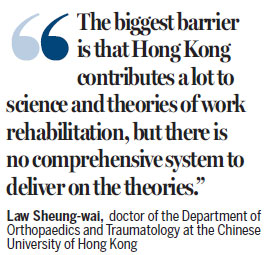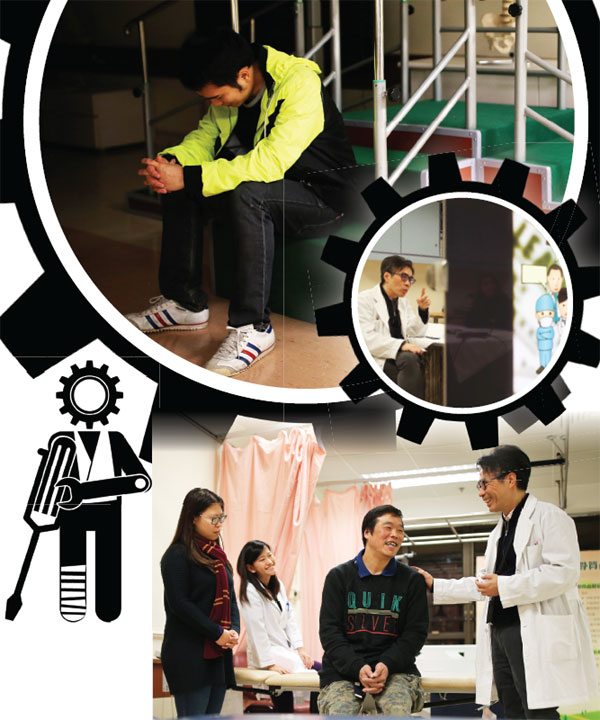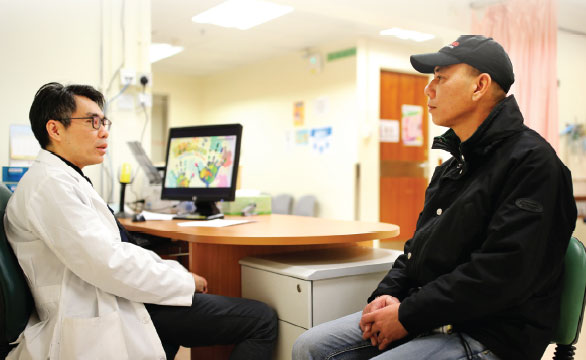Work injury: Who's got your back?
Updated: 2016-03-15 09:08
By Ming Yeung(HK Edition)
|
|||||||||
There are nearly 6,000 on-the-job injuries every year in HK. Those who suffer the most may face years of waiting for rehabilitation. Ming Yeung reports.
Hong Kong's unenviable record for workplace safety is long overdue for a complete overhaul. On the job fatalities in Hong Kong (5.2 deaths per 10,000 workers) are triple those of Australia (1.7/10,000 workers) and double those of Singapore (2.1/10,000 workers) on an annual basis. Of equal concern is Hong Kong's lack of facilities to treat the more than 55,000-60,000 work-related injuries occurring every year.
Local studies reveal that the Hong Kong public healthcare system doesn't even focus on work rehabilitation as part of its treatment approach. With 10 percent of work related injuries requiring at least three months of rehabilitation, the five-to-six thousand workers needing help are forced to wait in long queues, until the golden period for rehabilitation (within six months of the injury) has passed, by the time they receive attention. Since there's no workers compensation fund, employees sidelined by injury face the additional hardship of having no income.
K.K. Law had no idea what he was in for, after he was hurt in December 2014. It was his fifth day working on a new job at a local hotel. He and three fellow workers were moving some shelves. Law tumbled down some stairs and sprained his back.
He was ready to shake it off until a sharp pain in his back warning him, this was serious. He couldn't walk.
The Employees' Compensation Ordinance requires that employers pay any injured employee four-fifths of his monthly earnings at the time of the injury. Law had five days on the job. Not much there. He got HK$3,000. He couldn't go and see a private doctor with that and getting an MRI (Magnetic Resonance Imaging) scan in private hospitals was way out of reach.
Doctors told him he had a slipped disc and put him in the queue for therapy - a queue, stretching out for 150 weeks. Waiting time of two years to see an orthopaedic specialist for non-urgent cases are common in Hong Kong.
"The pain is perpetual but there is no way out," he sighs. "The first few months I could barely walk. Every 10 steps I had to stop for a break. My finances ran out and I was in despair," the 39-year-old recalls.
A glimmer of hope
The first ray of hope shone, when Law was invited to join the Multidisciplinary Orthopedics Rehabilitation Empowerment (MORE) program, under Dr Law Sheung-wai of the Department of Orthopaedics and Traumatology at the Chinese University of Hong Kong.
The MORE program, inaugurated in 2011, promises early diagnosis, prompt case management, and timely rehabilitation for injured workers, functional restoration and early return-to-work.
In other advanced economies, Dr Law acknowledges, patients suffering from work injuries are given specialized treatments to speed up recovery and get them back to work.
Not only do workers in Hong Kong have to repeatedly visit hospitals to get medical certification, Dr Law notes, those stuck in endless queues, are likely to develop secondary disabilities.
They get a little stir crazy from their disability and inactivity. They get depressed, start losing self-respect and may commit suicide, says Professor Paul Yip Siu-fai of the Department of Social Work and Social Administration at the University of Hong Kong.
Yip's department worked with the Employees' Compensation Insurance Residual Scheme Bureau on a survey to try to figure out why the local system for helping injured workers is so lamentably bad.
Labour Department statistics show that in 2013, for every 1,000 workers, there were 14.2 claims related to on-the-job injuries. That puts us, about in the middle when compared to other countries and regions based on International Labour Organization statistics.
Yip's research shows that after preliminary diagnoses, workers are left to deal with pretty serious pain with passive treatment, like taking rests and getting physiotherapy.
Dr Law adds his own perspective, noting lack of coordination and communication among referring doctors and other healthcare professionals all the way up the chain. In most cases, there are no case managers to care for injured workers and watch them progress toward returning to work. Dr Law argues these are failing that extend the recovery process substantially, and cause unnecessary misunderstanding between workers and their employers.
Chan Kwok-cheong suffered two work injuries over a two year period from 2010 to 2012. He's a maintenance worker for an electric company. During a routine check on a rainy night, Chan slipped and fell down some stairs and hurt his back. He reported the injury to his employers. Within a few days, the company's insurer assigned a case manager to handle all necessary procedures.
Chan joined the MORE program after having recurring back pain from his second injury. He recovered within three months. The first time he was hurt, it required more than a year going through the same routine channels that bedevil most injured workers.
"The biggest barrier is that Hong Kong contributes a lot to science and theories of work rehabilitation, but there is no comprehensive system to deliver on the theories," Dr Law points out.
The MORE program aims to fill that void, with orthopedics specialists at its core, liaising with specialists from other disciplines, including physiotherapists and occupational therapists. In their joint consultations, rehabilitation plans are devised for each patient.
Dr Law and his team have helped more than 300 injured workers since the program started nearly five years ago. The results have been positive. Among the 183 MORE patients who have been discharged, 64 percent have returned to work. That's more than double the success rate (31 percent) of those who receive only standard care.
Public-private interface
The success of MORE, Dr Law concedes, owes in large measure to the public-private interface. Some patients are able to use private medical services paid for by their insurance companies.
This fact limits more widespread application of the public-private interface because most injured workers prefer to go attend health services. Dr Law notes that part of the issue results from a widely held misconception that private doctors incline to set the interests of employers above those of injured workers.
Professor Yip points to a fact that all stakeholders in the current system fall prey to the rigid compensation-focused culture, which contributes to slow recovery and a poor return-to -work record.
"When the system focuses only on compensation, it would inevitably make employer and employee antagonistic," Yip says. "From more than 20 workers I interviewed, the majority badly wanted to get back to work but there are many barriers.'"
The climate of distrust creates avenues for recovery agents and lawyers to take advantage of a worker's vulnerability, encouraging litigation against employers. Litigation however adds considerable cost to the procedure, while injured workers often realize little gain for themselves.
"Injured workers in this vulnerable state are easily misguided, misled, and misinformed," Yip stresses.
Chui Kwok-yeung, 49, was working for a renovation contractor in early 2015 when he suffered a back injury. Chui's employer refused compensation, arguing he had not insured his workers on that project.
"He asked me to lie, and say the accident happened at another site which the employers had insured," Chui told China Daily. Besides covering his medical expenses and giving him HK$5,000 to buy "medication", Chui's employer refused to acknowledge the injury, thus denying Chui the statutory compensation of four-fifths of his salary during his recovery.

Mandy Tang Sze-man, organizer at the Association for the Rights of Industrial Accident Victims, explains work accidents must be reported to the Labour Department within 14 days of the accident either by employer or employee.
However, Tang says, the Labour Department has no authority to adjudicate disputes. If there is a dispute, it has to be handled by the courts. In any case, if an employer fails to meet his statutory obligation to pay compensation to an injured employee, the employer will not even be penalized, Tang adds. That's incentive for employers to deny their responsibilities, Tang adds.
With the help of Association for the Rights of Industrial Accident Victims, Chui awaits legal aid to pursue a claim against his old employer. In the meantime he is unable to go back to work and sits unemployed and idle at home. His self-confidence is pretty much gone. He feels like he's failed his family. He used to be the breadwinner.
Dr Law says the MORE program should be rolled out citywide, though it will continue to be limited by an absence of manpower and resources at public hospitals.
Yip believes the government's policy of equal care for all patients, regardless of whatever caused their affliction fails to account for the loss of productivity and the economic cost to the city and to workers who are not treated in a timely manner.
"By separating queues of injured workers from ordinary patients, not only can it speed up the treatment for injured workers, the queues for ordinary patients would be shorter too," Yip says. "Just like civil servants can attend special clinics, I believe injured workers should be given the same too."
Additionally, Yip urges employers to assign light duties to injured workers still in recovery.
In view of the rapidly aging working force, Yip foresees a growing number of work injuries, demanding a more aggressive approach to preventing and treating workplace disabilities. Although there has been systematic effort to promote on the job safety by various bodies, including the Occupational Safety and Health Council, Yip's research reveals a continuing lack of awareness of workplace safety, especially among migrant workers. Efforts to promote a safer work place often are undermined by sub-contractors, who show little regard for workers' safety.
Dr Law believes the best solution is to establish an occupational rehabilitation center where injured workers receive holistic care. Hong Kong's close neighbor Guangdong province opened a rehabilitation center for injured workers last year. Dr Law hopes that the SAR catches up fast, for the sake of workers, and for the city's economy.
Contact the writer at mingyeung@chinadailyhk.com
|
The MORE program promises early diagnosis, prompt case management, and timely rehabilitation for injured workers. Edmond tang / China Daily |
|
Dr Law Sheung-wai (left) notes those stuck in endless queues in public hospitals are likely to develop secondary disabilities. Edmond tang / China Daily |
(HK Edition 03/15/2016 page8)

